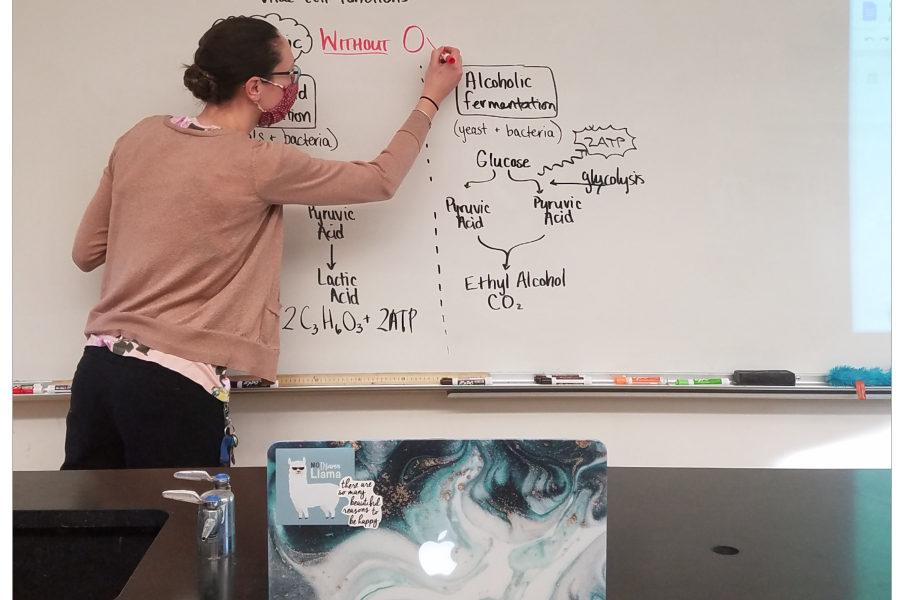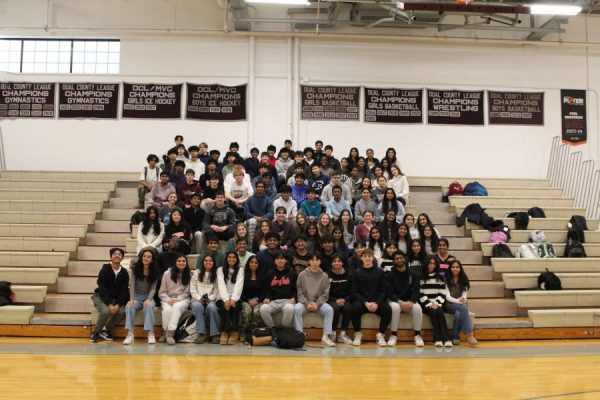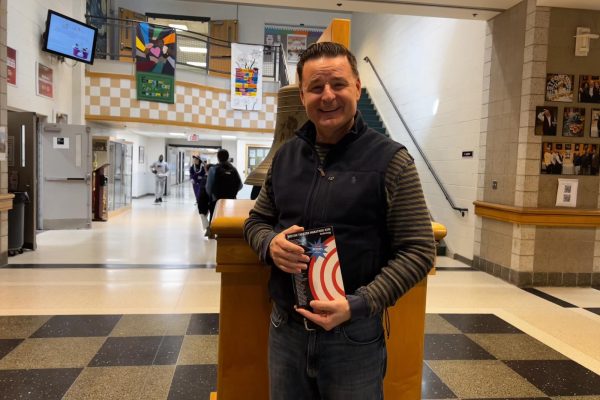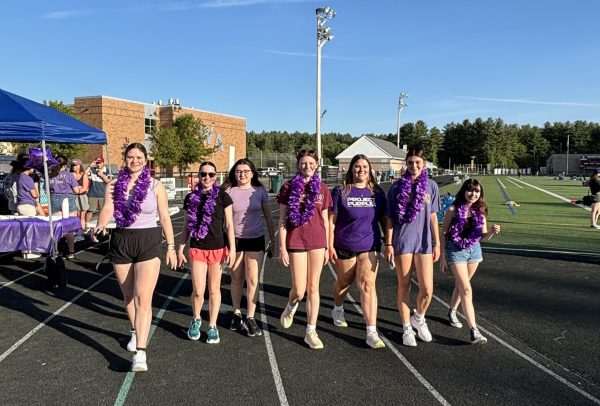WA teachers share experiences with hybrid model
Science teacher Alexandra Wilson teaches a biology class with students streaming in from home facing the whiteboard.
Now that half of the school year is over, opening a Google Meet call while conversing with students in the classroom isn’t something new to teachers. Teachers can now make sure that remote and in-person students are engaged and understand the material planned for the day.
This school year (2020-21) because of the pandemic, the hybrid model is in use. That means most of the student body is at home streaming into the live class at school. Although this system at first had teachers puzzled, as the year has gone on, they have learned to adapt.
German teacher Ashley Smith teaches students in ninth, eleventh, and twelfth grades. She has multiple strategies and websites that she uses to effectively teach all of her students.
“I’m a big Google Slides person because it’s one place I can keep everything for the day. [With Google Slides,] my plan for the day and the resources we’re going to be using is all in one spot,” Smith said. “I also like Pear Deck because it allows [students] to interact and share their thoughts, opinions, questions, etc. without necessarily having to raise their hand. Especially because of our shortened classes in the afternoon, it’s not always possible to hear from every student.”
Science teacher Alexandra Wilson, who teaches ninth-grade biology and tenth-grade chemistry, also likes to use interactive websites such as Pear Deck and Kahoot.
“[Pear Deck and Kahoot] are all really good resources that allow you to engage people at the same time no matter where they physically are, so they are very helpful,” Wilson said.
Teachers also regularly use the tools and products that are part of Google Workspace, such as Google Drive, Google Meet, and Google Classroom.
“We’re a Google school so we are encouraged to use the Google [Workspace], which means we’re using Google Meet, but we’re also using things like Google Docs and Google Jamboard,” Wilson said. “And those are really useful, depending on the lesson and what you’re trying to engage students with.”
Smith and English teacher Kathryn Flinner use Google Jamboard, which is a digital whiteboard-like software where students can post and draw thoughts and ideas.
Flinner, who teaches ninth and eleventh grades, tries to make pen-and-paper activities digital so that students would get a similar experience as they would in a normal year. For example, Flinner converted an activity where students would cut up pieces of paper into a drag-and-drop Google Slides activity.
While there are many remote and digital adaptations of normal activities, teachers have only three of the normal four or five hours per week to implement the ideas.
“I think there are gaps in terms of content that’s covered this school year, not necessarily in amount but perhaps in depth,” Smith said. “We might not get to do every activity that I would normally do in a certain unit but it doesn’t mean we’re not going to do the unit at all.”
Flinner also believes that students wouldn’t be missing any material but would be missing the nitty-gritty details.
“We haven’t lost anything in terms of the quality or the depth of the skills that you should be learning in the classroom,” Flinner said. “There’s definitely exposure that [students] won’t get, but in [English] I don’t see a learning loss. I see a coverage loss but not a learning loss. That’s two different things.”
Wilson thinks that the lowered amount of in-person learning time and the resulting amount of homework will prepare students for later on in life.
“I think in some ways [students] may not be learning as much detail in the content but on the other hand, they’re definitely increasing their independent learning skills beyond what they might have experienced in a normal year,” Wilson said.
As for labs, Wilson said she modified labs in the beginning of the year where students at school did the hands-on process while students at home observed and did work such as setting timers and recording data. But that didn’t turn out to be as fun for the remote students, Wilson said.
“We did purchase a Labster program, which is a virtual learning software program that has a lot of great labs in it that are all completely virtual,” Wilson said. “You have to like, [click the button to] pick up the beaker, put it on the balance, record the mass, remove it. It asks you [comprehension] questions. It’s cool and it helps to a certain degree, but at some point, a lab just becomes less fun when you’re not actually touching the equipment.”
For Flinner, lesson plans have become harder to create because she wants to make assignments as creative as she can.
“Planning takes forever because I have to think about what it is that I want the students to get. […] I’m trying really hard not to worksheet [students] to death,” Flinner said.
Planning what Smith will do in class has become equally easier and harder for her because she utilizes the one-hour lunch break to finalize and come up with plans for classes with the other German teacher, Tim Welch.
“Having a class only twice a week does mean you have to plan for less. Which, in some cases, lightens the planning load of a teacher,” Smith said. “That being said, I would trade it all in a heartbeat to actually be able to see [students] every day. […] I’ll talk and I’ll compare notes and ideas with Herr [Mr.] Welch, the other German teacher, because he also stays at the school.”
Teachers’ relationships with their students, however, haven’t majorly changed.
“I would definitely have gotten to know [students] better, faster, if we had been meeting every day,” Smith said. “I love when everyone has their cameras on, obviously because it makes it feel the most like a real class. I really encourage and want my RLA students to have their cameras on.”
Wilson encourages students to keep their cameras on in class as it gives her a face to associate names and voices with. However, she hasn’t made it a requirement or grade for students based on whether they have their camera on or not.
“It’s difficult to require students to keep their cameras on as you don’t know what may be happening in their homes,” she said. “I feel uncomfortable asking them to broadcast their personal lives so I do strongly suggest that students have their cameras on during class, but it is not a requirement for me.”
Flinner encourages students to keep their cameras on to make sure students are participating.
“When [students are] physically in front of me, I feel like I have a handle on [making sure they are paying attention]. I am starting to on occasion just try to throw out a question here and there [so students can answer and pay attention],” Flinner said. “But I don’t know that I’m managing that in the best way possible.”
While teachers want students to have their cameras on and pay attention in class, sometimes Google Meet doesn’t work. And different teachers have similar strategies to deal with when that happens. Google Meet has lagged and affected all WA classes a couple of times this year.
“I actually ended up having to go on my phone […] and post a message to my classes on Google Classroom […] I kind of short handedly assigned them some asynchronous work to do,” Smith said.
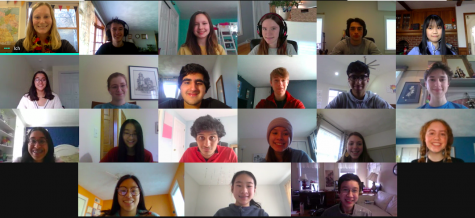
Smith also runs the German Club, and they meet every two weeks on a Google Meet. German Club has done multiple activities this year, such as Kahoots and even baking, when each member bakes in their own home while on the Meet with everybody else.
The constant outlining and revision of plans has made teachers more adept at solving problems that come their way.
“It’s always weird when you’re teaching something and then you’re like, ‘don’t come any closer’ so it gets to be a little bit strange,” Wilson said. “It’s definitely changed some of the ways that I would move around the classroom and make it feel more like a group setting.”
But, all in all, teachers care about their students and want them to have a good high school experience they will remember.
“My heart breaks for some kids because I just want them to have a happy experience,” Wilson said. “It’s been really, really tough. […] We’re like a family. And this year I am trying to get the same vibe.”

